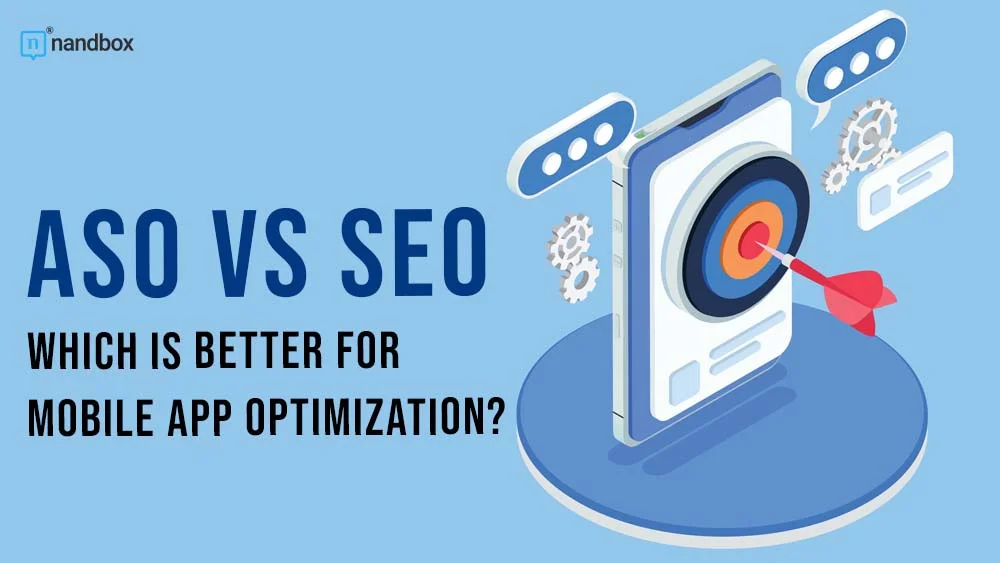What does ASO vs SEO mean? Mobile application development is one of the fastest-growing industries in the world. In 2021 alone, its global market size was estimated at USD 197.2 billion and market research analysts project the industry’s valuation to reach a staggering USD 583 billion by 2030, with a CAGR of 12.8%. Needless to say, mobile app development is a highly sought-after industry, especially with the overwhelming popularity of mobile devices. More people are developing mobile apps annually, hoping to compete with industry giants. Currently, there are around 9 million mobile apps in existence across industries. The question is: with this tight of a competition, how can mobile app developers elevate their apps from the rest?
The answer: Mobile app optimization.
However, mobile app optimization can come in two different forms:
- App Store Optimization (ASO)
- Mobile App Search Optimization (Mobile App SEO)
What is the difference between the two, and which is better for your mobile app campaign? Keep reading because we’ll take a deep dive into ASO vs SEO!
ASO vs SEO: What’s the Difference?
You might have heard of SEO before, right? Anyone who hasn’t been living under a rock knows what search engine optimization is.
App store optimization, on the other hand, is an up-and-coming concept that has gained quite a lot of traction with the rise of mobile apps and devices.
So, what are they exactly?
What is Mobile App Search Optimization (Mobile App SEO)?
In order to uncover mobile app SEO, it’s crucial to first understand what basic search engine optimization is.
Search engine optimization is the process of improving website visibility and ranking on search engine results pages. Mobile app search optimization applies the principles of SEO and focuses on optimizing your app to rank higher in search results SERPs.
Why is Mobile App SEO Important?
Mobile app SEO attracts users who are looking for apps through general search queries. Typically, users conduct initial background research or investigation on mobile apps using search engines, like Google. With mobile app SEO, you can boost your app’s discoverability.
For example, imagine a user searching for the “best recipe organizer app” on Google.
Applications that employ good mobile SEO practices are more likely to appear in search results alongside websites.
This effectively exposes your mobile app to a wider audience looking for solutions to their needs, which, if convinced with your offer, translates into more organic downloads.
It’s important to note that mobile app SEO works best for mobile devices since once users click through your app, they are led to the dedicated app marketplace (Google Playstore or Apple App Store).
However, since mobile apps are made primarily for mobile devices, the same listing will not appear on PC search. Here is the same search query results on PC.
What is App Store Optimization (ASO)?
App Store Optimization (ASO) is the process of improving an app’s visibility within app stores like Apple App Store and Google Play Store. The ultimate goal of ASO is to increase organic downloads by ensuring your mobile app ranks high in search results and gets featured prominently within the app marketplace.
Like search engines, app marketplaces are also integrated with search functionalities. This allows users to search for desired apps within the app store’s interface (without going to search engines).
As opposed to mobile app SEO, app marketplaces have their unique algorithms that are distinct from Google’s. In other words, the optimization practices for ASO may differ from those of mobile app SEO.
Why is ASO Important?
App Store Optimization drives organic downloads within app marketplaces. By ranking high on search results, your app gains significant exposure to users actively searching for apps in your category. Mobile apps that require more scrolling to reach get fewer clicks and enjoy lesser organic downloads.
Here are the results of the query “recipe organizer” on app marketplaces (Android and iOS):
Sometimes, users skip the search engine investigation (mobile app SEO) and head straight to app stores. Having a strong ASO strategy can help you land more favorable spots on app store search results, resulting in immediate brand awareness from users versus mobile apps that land lower on app store search results.
Understanding the difference between mobile app SEO and ASO is inconsequential without knowing how to implement both strategies for your mobile app development campaign.
So, what are their respective best practices? Continue reading to find out the best practices for ASO vs SEO.
Mobile App Search Optimization Best Practices
Mobile app SEO is a crucial element in your app’s marketing strategy because users tend to investigate first before downloading applications. Moreover, Google states that 1 in 4 users find apps using search engines. Therefore it stands to reason that succeeding in mobile app marketing relies heavily on your mobile app search optimization.
Here are the best practices to succeed in mobile app SEO.
#1 Create a Dedicated Website
A website acts as your mobile app’s digital headquarters. Websites allow you to provide comprehensive information regarding your app that goes beyond the character limitations of app store descriptions.
You might think, “What is the use of my website if my target audience is mobile users?”
Well, it is a valid sentiment, however, you might be forgetting that websites work on both PC and mobile. Websites can be used to convey information, provide opportunities for content creation, and build credibility among searchers.
With a website, mobile app search optimization becomes way easier than trying to rank your app solely via Google SERP’s apps section.
#2 Index Mobile App on Google
While app stores are the primary source for app downloads, Google also allows app indexing of Android and iOS on SERPs.
When users search for apps within your category, indexed apps appear on search results with an install button. This streamlines the user’s search and the app-downloading process, leaving a positive user experience.
Here are other reasons why app indexing is crucial for mobile app SEO:
- Increased Visibility: Indexing your app on Google allows it to appear in search results when users search for keywords related to your app, expanding your discoverability beyond just the app store.
- Deeper User Engagement: App indexing allows users to access specific in-app content directly from SERPs, which is useful if your app offers deep linking functionalities for specific content sections.
#3 Perform Comprehensive Keyword Research
Keyword research is the foundation of any successful SEO strategy, mobile app SEO included.
With comprehensive keyword research using an SEO tool, you can find the specific words, language, or search query used by your target audience
These keywords can be integrated into your website content, app store listing, and even in-app content, increasing the chances of your mobile app appearing on relevant searches.
#4 Craft High-quality and Relevant Content
With a website and essential keywords at your disposal, the best foot forward in your mobile app SEO campaign is content creation, particularly blog articles.
Blog articles hold immense power in ranking your mobile app on search results.
First, informative and engaging content around your app can educate users about your unique value proposition.
Second, consistently publishing high-quality, keyword-rich content helps establish you as the thought leader in the industry, attracting valuable traffic.
Finally, blogs are passive sales personnel, which means users can organically download apps based on your article’s direct response copy.
Of course, using content marketing on your mobile app is pointless if search engines do not index your web pages. IndexCheckr is a tool that allows users to automatically check the indexing status of pages and connect websites with verified indexers to expedite the indexing process.
#5 Build Links Effectively and Efficiently
Link building is a crucial ranking factor in search engine algorithms. Backlinks, for example, are considered “votes of confidence” from other websites, which increases your site’s perceived authority on Google.
However, there’s more to links than just backlinks. Internal links matter just as much on mobile app SEO.
Aside from publishing high-quality content, building links also helps boost your search visibility.
Unfortunately, not all backlinks are effective.
Inbound links coming from low-quality sites or link farms can do more harm than good. To this end, having backlink monitoring software like Linkody helps assess the quality of your backlinks and gives you the ability to disavow them as needed.
On the other hand, internal linking is also crucial for mobile app search optimization. The only problem is, building internal links is tedious and time-consuming.
Automated internal linking software, like LinkStorm, can help in speed up the process by finding internal links for you. As a result, you can easily boost the SEO of your app’s website without the hassle of manual link building.
App Store Optimization Best Practices
Search engines are the perfect navigation systems for finding any information, mobile apps included. However, since mobile apps are created for mobile consumption and app marketplace optimization, right?
“Correctamundo!” —Jules Winfield, Pulp Fiction (1994)
Users are indeed more likely to find and download apps by browsing app marketplaces. According to Think With Google, nearly half of people find new apps in app stores. That being said, ASO is also an important strategy to integrate into your app marketing repertoire.
Here are best practices for doing app store optimization:
#1 Optimize Your App’s Title and Description
In most app marketplaces, users will not be able to see your description from the search result interface. That means you need a compelling title to get users interested in what your mobile app has to offer.
Short, catchy, and witty titles are effective in capturing your target audience’s attention. If possible, reflect the app’s core functionality in the title.
For example, “Duolingo: Language Lessons” captures the essence and functionality of the app. It is an application aimed at teaching users another language.
Once you find the perfect title, it’s time to consider how to craft your descriptions. Keyword research will play a critical role in app descriptions because people might use search queries or keywords to find apps. In this case, integrate as many keywords into your description naturally, while keeping readability scores high.
#2 Use High-quality Multimedia Content
Aside from your title and descriptions, multimedia content can affect your ASO and click-through rates.
Remember, your logo is the first thing users see. Even with enticing titles, a poor logo may still break your ASO campaign.
It’s also important to ensure that your multimedia is filled with high-quality graphics and screenshots. Professional-looking screenshots of your app’s interface and key features can attract users to learn more.
Another option is adding short video previews to demonstrate your app’s functionality in action. This gives users a clearer picture of what awaits them.
#3 Place Your Mobile App in the Correct Category
App stores categorize apps for easier browsing. Choosing the right category is crucial for discoverability. Here’s what to consider:
- Primary Category: Select the most relevant category that accurately reflects your app’s core functionality.
- Subcategories (if applicable): Some app stores allow selecting subcategories within the main category. You must utilize this option to further refine your app’s categorization.
- Research Competitor Placement: See which categories similar apps are using to gain valuable insights when categorizing.
#4 Encourage Positive User Reviews
Don’t you notice that apps with more positive ratings and download count often dominate app store search rankings? Positive user reviews and ratings are gold in ASO for any app marketplace.
To land better positions on ASO search results, positive reviews are needed. One way to gain this is through the delivery of exceptional user experience. When users genuinely enjoy your application, they will feel compelled to let you and other users know.
Prompting for reviews is also an acceptable practice in mobile app marketing. However, it is important to do this at the appropriate moments within your app. Otherwise, spamming a review request may leave a bitter taste on your app, resulting in negative reviews instead.
Remember to always thank users for positive feedback and address negative reviews promptly. This assures them that you care about their user experience. Of course, don’t make promises you cannot keep!
So, Which is Better for Mobile App Optimization?
App store optimization and mobile app search optimization are both crucial marketing strategies when marketing mobile apps. In this article we explored ASO vs SEO in terms of benefits and ASO vs SEO in terms of best practices.
While both optimize apps for search queries, ASO and SEO have distinct targets. Mobile app SEO focuses on search engines like Google and ASO concentrates on mobile marketplace searches.
Since users are found in both search engines and app stores, there should be no comparison on which strategy is better. Instead, mobile app SEO and ASO should be implemented complementarily to maximize your marketing ROI.
Diverting attention to just one significantly limits a mobile app’s visibility and reach. But with both strategies at your disposal, you can dominate both competitive arenas.








